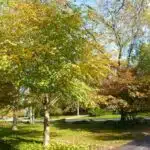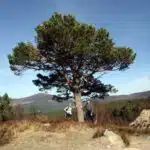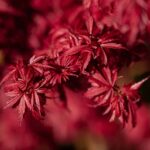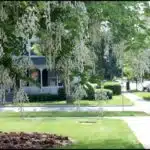As landscape horticulturists, we strive to create beautiful outdoor spaces that not only enhance the aesthetic appeal of our homes and businesses but also provide a range of ecological benefits. Trees are an essential element in this endeavor, offering shade, beauty, and habitat for wildlife. However, not all trees are created equal, and some species can cause significant problems in the landscape. In this article, we will discuss nine landscape trees you shouldn’t plant due to their invasive nature or potential to cause damage.
When selecting trees for your property, it’s important to consider factors such as soil type, drainage, sun exposure, and space availability. The wrong tree in the wrong place can lead to a host of issues down the line, from root damage to pest infestations. Additionally, some trees may have aggressive growth habits that allow them to outcompete native plants or spread beyond their intended location. By avoiding these problematic species and choosing appropriate alternatives instead, you can create a healthier and more sustainable landscape that benefits both you and the environment.
The Importance Of Tree Selection
Selecting the appropriate tree species for your landscape is an essential aspect of creating a beautiful and healthy environment. However, it can be challenging to choose the right species that will thrive in your area. The benefits of native trees cannot be overstated as they are well adapted to the local climate, require less water, and provide food and habitat for native wildlife.
The impact of climate change on tree selection cannot be ignored. As temperatures rise, droughts become more frequent, and rainfall patterns shift, it is crucial to choose trees that can withstand these extreme conditions. Selecting trees that are tolerant of heat stress, drought, and poor soil conditions will ensure that your landscape remains green and healthy even under adverse climatic conditions.
Incorporating native trees into your landscape design has numerous benefits. They have co-evolved with local wildlife over time; this means they provide food and shelter for birds, bees, butterflies, and other beneficial insects. Additionally, they support the local ecology by providing homes for native animals while also reducing the carbon footprint in their locality. Understanding the importance of selecting the right tree species is critical when choosing which varieties to plant in your garden or community park. Invasive species can cause significant harm to both human health and natural ecosystems; therefore, it’s important to understand their harmful effects before making any planting decisions.
Invasive Species And Their Harmful Effects
Invasive species can have a significant effect on the environment and economy. In some cases, these species can outcompete native species and disrupt the natural balance of an ecosystem. Landscape horticulturists should be aware of the potential for ecological damage that can be caused by introducing certain species into an environment. Some of the most common landscape trees that should not be planted due to their invasiveness include Norway maple, Russian olive, and Tree of Heaven. These species can rapidly spread and displace native flora, leading to soil erosion and decreased biodiversity. The economic costs associated with invasive species can be significant, as they can damage infrastructure and require significant resources for removal or control. It is important for landscape horticulturists to be aware of the risks of introducing invasive species and the potential harm they can cause.
Invasive Species
Landscape trees are beautiful additions to any garden or outdoor space, but not all species are created equal. Some trees can be invasive and cause harm to the environment around them. Invasive species often spread rapidly and outcompete native plants, leading to a loss of biodiversity. As landscape horticulturists, it is our responsibility to prevent the spread of these harmful species by educating ourselves and our clients.
Preventing the spread of invasive tree species should be a top priority for anyone who loves nature. One way to do this is by choosing non-invasive alternatives when selecting new trees for planting. Many nurseries now offer a wide variety of non-invasive trees that are just as beautiful as their invasive counterparts. Additionally, knowing which species are invasive in your area can help you avoid planting them altogether.
Control measures must also be taken when dealing with existing invasive tree species within your property. Regular inspections and monitoring will help identify any potential problems before they become too big to handle. If an invasive tree is found on your property, it may be necessary to remove it entirely. However, this should only be done with caution and following proper procedures to prevent further spread.
In conclusion, preventing the spread of invasive tree species is crucial for maintaining a healthy ecosystem. As landscape horticulturists, we have a responsibility to educate ourselves and our clients on the dangers of these harmful trees and work towards finding alternatives that benefit both us and the environment. By implementing control measures and choosing non-invasive options, we can protect our natural surroundings for generations to come.
Ecological Damage
Invasive tree species can cause significant ecological damage, which can affect the surrounding environment and harm native plants and animals. Invasive trees have the potential to outcompete native trees, reducing biodiversity in the ecosystem. The loss of biodiversity can lead to a decline in ecosystem services that are essential for human well-being, such as clean air and water, soil fertility, and climate regulation. As landscape horticulturists, we must understand the impact of invasive tree species on ecosystems and work towards ecological restoration and habitat conservation.
The ecological damage caused by invasive tree species can be challenging to reverse. However, by implementing control measures and removing invasive trees from affected areas, we can mitigate some of their harmful effects. Ecological restoration is an effective approach to repairing damaged ecosystems caused by invasive tree species. This process involves restoring natural habitats by reintroducing native plant species that will improve soil health, attract pollinators, and provide food sources for wildlife.
Habitat conservation is another important aspect of preventing further ecological damage caused by invasive tree species. Conserving natural habitats helps maintain biodiversity and prevent further spread of invasive trees into other areas. By preserving natural habitats through proper land management practices such as controlled burns, pruning or removal of mature trees that could fall onto other vegetation or infrastructure during storms, we can protect our environment for future generations while also promoting sustainable landscaping practices.
In summary, the ecological damage caused by invasive tree species is a serious concern that requires immediate attention from landscape horticulturists. Through ecological restoration and habitat conservation efforts along with proper control measures such as identifying and removing invasive trees from affected areas – we can mitigate the harmful effects of these destructive trees on our environment while promoting sustainable landscaping practices that benefit both us and nature alike.
Economic Costs
Another harmful effect of invasive tree species is the economic cost they can impose on individuals, communities, and governments alike. These costs can come in various forms, such as direct expenses for control measures, loss of revenue from damaged crops or properties, and long-term expenses for ecological restoration efforts. As landscape horticulturists, it’s important to understand the economic impact of invasive trees so that we can make informed decisions about their management.
A cost-benefit analysis is a useful tool for evaluating the economic impact of invasive tree species. The analysis involves comparing the costs associated with controlling or removing an invasive tree species to the benefits gained by doing so. Although control measures such as herbicides or mechanical removal may have upfront costs, they can save money in the long run by preventing further damage to ecosystems and reducing the need for expensive restoration efforts down the line.
However, despite these potential savings, there are still significant economic costs associated with managing invasive tree species. For example, businesses that rely on natural resources such as timber or tourism may suffer losses due to decreased biodiversity caused by invasive trees. Additionally, governments may face expenses related to monitoring and enforcing regulations to prevent further spread of invasive species. As landscape horticulturists, it’s crucial that we consider both the short-term and long-term economic impacts of invasive tree species when making decisions about their management.
Tree Roots And Their Impact On Infrastructure
Invasive species have devastating effects on ecosystems and biodiversity. They can displace native plants and animals, alter water cycles, and cause soil erosion. However, invasive species are not the only concern for landscape horticulturists. Tree root damage is a serious issue that can impact infrastructure maintenance.
Tree roots are essential for the health and growth of trees, but they can also cause significant damage to sidewalks, driveways, and underground pipes. As tree roots grow, they can penetrate through concrete or asphalt, resulting in costly repairs. In addition to physical damage, tree roots can also interfere with water lines and sewage systems.
To prevent tree root damage, it is important to understand the growth habits of different tree species. Some trees have aggressive growth habits that make them more likely to cause damage than others. These trees should be avoided when selecting landscape trees. Instead, consider planting slow-growing trees with non-invasive root systems such as dogwood or Japanese maple.
- Proper placement of trees away from infrastructure is crucial in preventing root-related issues.
- Regular inspection of infrastructure throughout landscapes will help identify any potential root-related issues before they become major problems.
- Proper installation techniques such as vertical mulching allow for healthy growth while also preventing future damage.
- Selecting species with non-invasive root systems such as dogwood or Japanese maple will help reduce the risk of future root-related issues.
In summary, understanding the potential for tree root damage is vital in maintaining infrastructure within landscapes. By avoiding trees with aggressive growth habits and properly placing new plantings in relation to infrastructure areas we are able to reduce the potential for these types of issues to occur. Additionally regular inspections and proper installation techniques will help minimize potential impacts from an established planting.
Trees With Aggressive Growth Habits
While trees can add beauty and value to a landscape, some species have aggressive growth habits that may cause problems in the long run. One common objection to avoiding these trees is that they provide quick shade or privacy. However, it’s important to consider the potential consequences before planting them.
Controlling growth is one way to manage aggressive tree species. This can involve regular pruning, shaping, and removing suckers or root sprouts. However, this requires ongoing maintenance and may not always be effective in preventing damage to nearby structures or other plants. Additionally, some of these trees have roots that can damage sidewalks, driveways, and underground utilities.
Alternative options for landscaping include slower-growing tree species that are less likely to cause problems in the future. These trees may take longer to establish themselves but are ultimately more sustainable and require less maintenance. Consulting with a professional landscaper or arborist can help identify suitable options based on the specific needs and goals of your property.
| Aggressive Trees | Alternative Options |
|---|---|
| Silver Maple | Red Maple |
| Weeping Willow | River Birch |
| Bradford Pear | Serviceberry |
| Mimosa | Dogwood |
| Norway Maple | Japanese Maple |
In summary, while some trees may seem appealing for their quick growth or aesthetic appeal, it’s important to consider their long-term impact on your landscape. Controlling growth through regular maintenance is an option but may not always be effective in preventing damage. Instead, alternative options such as slower-growing tree species should be considered for a more sustainable and low-maintenance landscape. The next section will explore species that attract pests and diseases and their potential impact on your landscape.
Species That Attract Pests And Diseases
Pest and disease control is a major concern for landscape horticulturists, as it can significantly affect the health of trees and plants. To maintain healthy landscapes, it is important to choose trees that are resistant to pests and diseases. Pest-resistant landscaping involves selecting the right species of trees that do not require excessive use of pesticides or other chemicals.
One way to ensure pest resistance in trees is to select species that are native to the area. Native species have adapted to local conditions, including pests and diseases prevalent in the area. These trees are naturally resistant and require less maintenance compared to non-native species. Disease-resistant trees are also crucial as they can resist common diseases such as powdery mildew, anthracnose, or oak wilt.
Another factor that plays a critical role in pest resistance of trees is their overall health. Trees that are stressed due to factors such as poor soil conditions, inadequate nutrients, or lack of water are more susceptible to diseases and pests. Therefore, it is important to maintain proper care for these trees by providing regular watering, fertilization, pruning, and adequate sunlight exposure.
To ensure pest-resistant landscaping, it is recommended to plant a diverse range of tree species in your landscape. This will create a natural ecosystem where beneficial insects can thrive and help control harmful pests. Additionally, planting different tree species will prevent pests from attacking large areas of monoculture.
Four Examples of Pest-Resistant Tree Species:
- Red Maple (Acer rubrum) – Resistant to common maple pests such as borers and scale insects.
- Bald Cypress (Taxodium distichum) – Resistant to fungal diseases such as root rot and cypress canker.
- American Holly (Ilex opaca) – Resistant to most pests and diseases.
- Eastern Red Cedar (Juniperus virginiana) – Resistant to many fungal diseases that affect conifers such as cedar apple rust and cedar-quince rust.
Moving on to the next section, trees that produce excessive debris in landscapes can be a nuisance to homeowners.
Trees That Produce Excessive Debris
Many homeowners are guilty of planting trees that produce excessive debris, which can be a nuisance to clean up. These trees may also cause damage to property and require frequent maintenance. To avoid these problems, it is important to choose the right type of tree for your landscape.
One alternative option to consider is using mulching techniques instead of planting trees that produce excessive debris. Mulch is an organic material that is spread over the soil surface around plants and trees. It helps retain moisture in the soil, suppresses weed growth, and regulates soil temperature. There are various types of mulch available such as wood chips, bark, straw, leaves or composted materials.
If you still prefer having trees in your landscape but want to avoid those that require high maintenance, there are some options available. For example, evergreen trees like pine and spruce require less pruning than deciduous trees like maple or oak. Additionally, smaller ornamental trees like dogwood or magnolia are easier to maintain than larger shade trees like ash or poplar. It is important to research the specific needs of each tree before planting them in your landscape to ensure they will thrive with minimal maintenance required.
Transition: While low-maintenance landscaping options may be appealing to many homeowners, there are still some who prefer the beauty and benefits provided by certain high-maintenance trees. However, it’s important to understand the level of care required before choosing one for your landscape.
Trees That Require High Maintenance
Japanese Maple trees are known for their striking foliage and their beautiful fall colors, however, they require a great deal of maintenance, as they are susceptible to many diseases and pests. Magnolia trees often require substantial pruning to maintain their attractive shape and they need frequent fertilization to ensure they flower properly. Birch trees are known to be fast-growing but they can quickly become overgrown and require constant pruning and maintenance to keep them in shape. All three species require regular watering and mulching to ensure proper soil nutrition and moisture levels.
Japanese Maple
Japanese Maple is a popular landscape tree that is known for its vibrant colors and delicate leaves. However, it requires high maintenance and may not be suitable for all homeowners. Pruning techniques must be employed regularly to maintain the tree’s shape and prevent overcrowding. Neglecting pruning can lead to an unkempt appearance and may even cause damage to nearby structures.
In addition, Japanese Maples have specific soil requirements that need to be met in order for the tree to thrive. They prefer well-draining soil with a slightly acidic pH level. If the soil conditions are not ideal, the tree may suffer from stunted growth or disease. It is important to do a soil test before planting this tree to ensure that the soil meets its requirements.
Overall, while Japanese Maples are beautiful trees, they require a significant amount of upkeep and may not be appropriate for all landscaping situations. Homeowners who are willing to devote time and effort into maintaining this tree will be rewarded with its stunning appearance. However, those who do not have the resources or commitment to properly care for it should consider other options.
Magnolia
Magnolias are a popular tree species that are known for their stunning flowers and fragrant scent. They have become a staple in many residential landscapes due to their beauty and ornamental value. However, they require high maintenance and may not be suitable for all homeowners. The question of whether Magnolias are flowering beauties or invasive species has been debated among horticulturists, but it is widely accepted that these trees require careful attention to thrive.
Magnolia tree care involves several key tips and tricks to ensure its optimal growth. These include proper pruning techniques, soil conditions, and pest management. Pruning should be done regularly to maintain the tree’s shape and prevent overcrowding. Magnolias prefer well-draining soil with a slightly acidic pH level, so it is important to conduct a soil test prior to planting. Pest control measures should also be taken to prevent damage from insects such as scale or whitefly.
Despite the high maintenance requirements of Magnolia trees, their beauty makes them a worthwhile addition to any landscape. Their vibrant flowers and sweet fragrance can enhance the overall aesthetic appeal of a property. With proper care and attention, homeowners can enjoy the benefits of this stunning tree species for years to come.
Trees That Can Cause Allergies And Health Issues
Did you know that allergies affect up to 30% of the global population? It is no secret that tree pollen is one of the most common allergens. As such, planting trees that can cause allergic reactions and health concerns should be taken seriously. In this section, we will delve into some of these trees.
Firstly, let’s talk about the Bradford pear (Pyrus calleryana). This ornamental tree has become popular for its spring blooms and fall color. However, it has also been known to cause allergic reactions in susceptible individuals due to its strong fragrance. Additionally, it is prone to splitting at its weak branch unions and can cause property damage.
Secondly, the Leyland cypress (x Cupressocyparis leylandii) should be avoided if you have asthma or other respiratory issues. This fast-growing evergreen tree is often used as a screening plant due to its dense foliage. However, it emits a high amount of volatile organic compounds (VOCs), which can irritate the lungs and exacerbate pre-existing conditions.
Lastly, if you live in an area prone to wildfires, avoid planting eucalyptus trees (Eucalyptus spp.). These non-native trees are known for their flammable oils and can increase the risk of fires spreading. Additionally, they have been known to cause skin irritation and respiratory issues in some people due to their essential oils.
- Trees That Can Cause Allergies and Health Issues:
- Bradford pear (Pyrus calleryana)
- Leyland cypress (x Cupressocyparis leylandii)
- Eucalyptus trees (Eucalyptus spp.)
- Black walnut (Juglans nigra)
- Red cedar (Juniperus virginiana)
As landscape horticulturists, it is our duty to ensure that we are not contributing to any health issues or environmental problems. By avoiding trees that can cause allergic reactions or health concerns, we are not only benefiting individuals but also the larger ecosystem. It is important to do thorough research and consult with professionals before planting any trees on your property.
Moving forward, let’s explore non-native trees and their negative impact on biodiversity. While importing exotic trees may seem like a good idea for aesthetic purposes, it can have detrimental effects on the local flora and fauna.
Non-Native Trees And Their Negative Impact On Biodiversity
Trees that can cause allergies and health issues are not the only concern when it comes to selecting trees for your landscape. The use of non-native species can also have negative effects on biodiversity conservation. Non-native species are those that come from a different geographic area and do not naturally occur in the region where they are planted. These trees may outcompete native species, causing a decline in local biodiversity.
Non-native species often lack natural predators or diseases, allowing them to spread rapidly and dominate ecosystems. This can lead to a decrease in food and habitat for native wildlife, ultimately affecting the entire ecosystem. Additionally, non-native species may require more water or fertilizer than native species, increasing resource consumption and potentially leading to soil degradation.
To conserve biodiversity and promote healthy ecosystems, it is important to choose trees that are native to your area. Native trees have adapted to local environmental conditions and provide essential resources for wildlife. When selecting trees for your landscape, consider factors such as soil type, sun exposure, and water availability to ensure you choose a tree that will thrive in its environment without negatively impacting local biodiversity.
As responsible stewards of our landscapes, we must carefully consider the impact our choices have on the environment around us. By choosing native species over non-native ones in our landscaping efforts, we take an important step towards protecting biodiversity and promoting healthier ecosystems. Next up: Choosing the right trees for your landscape.
Choosing The Right Trees For Your Landscape
As the old saying goes, “Choose the right tree for the right place.” This is especially true when it comes to landscaping. While there are some trees that may seem appealing, they may not be suitable for your landscape. In this section, we will discuss how to choose the right trees for your landscape based on native vs exotic options and size and space requirements.
Firstly, it is important to consider whether you want to plant native or exotic trees in your landscape. Native trees have adapted to the local climate and soil conditions and are more likely to thrive without much maintenance. Exotic trees, on the other hand, come from a different region and may require more care and maintenance. However, they can also add unique beauty to your landscape.
Secondly, size and space requirements should be taken into account when selecting a tree. Consider how much space you have in your yard and how tall you want the tree to grow. Choose a tree that fits well in its surroundings while not obstructing any views or growing too close to any structures.
In summary, choosing the right trees for your landscape involves considering native vs exotic options as well as size and space requirements. By taking these factors into account, you can select a tree that will thrive in its environment while adding beauty to your property for years to come.
Conclusion
Tree selection is crucial in ensuring a healthy and sustainable landscape. Invasive species can lead to significant ecological damage, while aggressive growth habits and root systems can cause costly infrastructure damage. Trees that require high maintenance or attract pests and diseases can also be problematic. Furthermore, non-native trees can negatively impact local biodiversity.
It cannot be emphasized enough that selecting the right tree for your landscape is essential. Planting the wrong tree can result in long-term issues that are difficult to correct. As a landscape horticulturist, it is my responsibility to ensure that the trees I recommend are appropriate for the site and will not cause any harm or negative impacts.
In conclusion, choosing the right tree involves careful consideration of factors such as invasive potential, growth habits, pest attraction, and maintenance requirements. By avoiding trees with these negative characteristics, we can create a sustainable and healthy environment for future generations to enjoy. Remember, planting a tree is an investment in our future, so let’s make sure we choose wisely!
Image Credits
- “Joshua Tree Landscape” by josullivan.59 (featured)





























